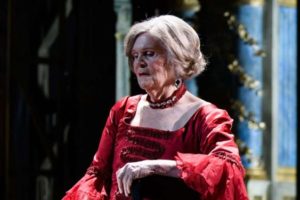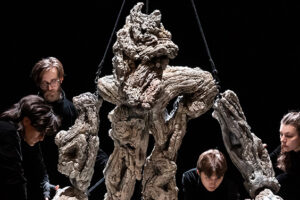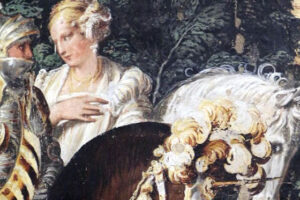

After I became a graduate teaching-assistant back in the previous century I was thrust into a large group office with a crew of older, savvier teachers and it proved an indelible formative experience. Not only did we talk—endlessly—about how to handle students and their myriad writing problems—we shared about art and movies and music.
Once I mentioned that I didn’t really like Bach which was greeted with withering condescension by a colleague whom I had grown to respect and adore. I confessed to her my naïve notion that I preferred Handel because he wrote for Man whereas I felt that Bach wrote for God which left me out of the equation.
His devout, mathematical, cerebral music has mostly remained not my “thing” although I have dutifully over the years attended multiple performances of one or the other of the Passions or the B-minor Mass, etc.
And yet a most “heaven-sent” experiences of my life occurred walking into the Thomaskirche (Bach’s church) in Leipzig for the first time and hearing an unseen violin playing in the choir loft. It was soon joined by a soprano rehearsing a cantata and I was transported.
Years later my baroque preferences haven’t altered much but as I’ve explored many more of Bach’s works I felt right at home when Thursday’s concert opened with one of my favorite sinfonias: the irresistible earworm that opens cantata 42.
Since I listen to HIP ensembles so often it required some adjustment encountering St. Luke’s lush modern string instruments tuned to 440 (rather than at lower baroque pitch) digging into Bach’s swirling figures, while its warm oboes and bassoon lacked the biting snarl one gets from older wind instruments. But Labadie emphasized the beguiling interplay between those winds, particularly Marc Goldberg’s keening bassoon, making it entirely fresh to me.
I’m generally impatient these days with talk from the stage during a concert—far too many conductors and singers feel the need to narrate in addition to perform—but Labadie’s lengthy sharing throughout was consistently elegant and informative.
He was especially helpful about the unknown second piece, Alles mit Gott und nicht ohn’ ihn BWV 1127, an extended aria in 12 (!) verses for soprano that had only been rediscovered in 2006. To everyone’s relief he and Teuscher performed just two of the dozen sections: she and just the continuo collaborated on the sweetly modest 8-line verses each followed by a sumptuous variation taken up by the entire orchestra alone.
However, that unprepossessing “new” work was merely a warmup for the lovely Teuscher whom I hadn’t heard since she shone as Aci in Handel’s Aci Galatea e Polifemo at Alice Tully Hall six years ago.
The German soprano then turned to perhaps the best-known of Bach’s solo cantatas, the dazzling Jauchzet Gott in allen Landen BWV 51in which she dueled adeptly with Carl Albach’s peppy trumpet. Her modest bright voice dealt effortlessly with the challenging curlicues if without the no-holds-barred bravura flashiness one has encountered with other sopranos.
The occasional exposed high notes in the concluding “Alleluja” were just lightly piped; she might have been more comfortable at a lower baroque pitch instead although her bio in the program suggests that she performs most often with modern-instrument ensembles.
During the Jauchzet, I was reminded of something that always bothered me about Bach’s vocal music. Coming to it after first inhaling loads of Handel and other Italianate composers, I could never understand why no one ornamented Bach’s da capo repeats. I once dated a baroque keyboardist and asked him about this and he looked at me like I was crazy: it seemed to have never occurred to him—it just isn’t done!
That musical asceticism probably also explained why I could never enjoy the deadly Karl Richter recording of Handel’s Giulio Cesare in which every ABA is unadorned, making for an interminable four hours!
After intermission Teuscher was joined by German countertenor Benno Schachtner for the program’s main event, Tilge, Höchster, meine Sunden BWV 1083, Bach’s fascinating arrangement of the much-loved Pergolesi Stabat Mater. Nearly three hundred years after its composition, the Italian’s setting for soprano and alto of the 13tjh century Latin hymn depicting the Virgin Mary’s suffering at the Crucifixion remains one of the most performed high baroque vocal pieces.
Just in the past several years the Pergolesi has shown up locally as a dance piece at both the White Light Festival and Montclair State University’s Peak Performances and it will return this fall to Lincoln Center with the Orchestra of the Age of Enlightenment and the ineluctable Iestyn Davies blending with Katherine Watson.
In fact. this very morning at the Salzburg Pfingstfestpiele Cecilia Bartoli and Franco Fagioli sang Pergolesi’s Stabat Materat the Mozarteum.
It might seem surprising that Bach would late in life rework a Roman Catholic masterpiece until one remembers that while his music keenly reflects the influences of his German predecessors like Buxtehude, Pachelbel, Schütz and others he often turned to Italian composers for inspiration. His keyboard concertos in particular freely adapt Vivaldi’s music that had traveled north into Bach’s hands.
Though I know the Pergolesiextremely well, most recently having experienced it as a theater piece two years ago as the final offering of the much-missed Loft Opera,
I admit to shirking my critical responsibility and hadn’t previously heard Bach’s version until Labadie, Teuscher and Schachtner performed it.
To my great surprise, for most of its length Tilge, Höchster remains instantly recognizable closely resembling its antecedent. The orchestral accompaniment is generally denser and more complex but the vocal line often remains relatively unchanged. Eventually Bach inserts himself more and more; in particular, the seventh and eighth movements, arias for the soprano then the alto begin with Pergolesi and then go off into more unfamiliar territory. Interestingly Bach also often eliminates high notes taking the vocal lines lower.
Though Zankel raised the lights slightly for the sung portions of the program, it was virtually impossible (for me, at least) to follow the text, a particular detriment during the second half when I was curious as to how Psalm 51 which Bach used differs from the Stabat Mater. Perhaps it was just as well as the solemn Biblical text occasionally doesn’t really fit as in the jaunty fourth movement “Dich erzurnt mein Tun” for alto.
I wasn’t looking forward to hearing Schachtner live for the first time. He frequently collaborates with countertenor-turned-conductor René Jacobs and the numerous broadcasts I’ve heard of their work together haven’t appealed to me much. However, in person, Schachtner’s voice proved smoother and warmer even brasher than I had expected. It reminded me a bit of Jacobs’s slightly unwieldy countertenor back in the day along with several others of that earlier time especially David Cordier’s.
There’s a glassy, hooty quality to Schachtner’s singing that isn’t consistently attractive but he blended beautifully with Teuscher’s cooler limpid sound. Their intense vocal collaboration, a fortuitous casting coup by Labadie, succeeded wonderfully well and put forth a strong argument for Bach’s re-envisioning of the most lasting work from the composer’s tragically short life of just 26 years.
Labadie has recorded Tilge, Höchster, meine Sunden with Karina Gauvin and Daniel Taylor and his other orchestra Les Violons dur Roy and I am now eager to hear that interpretation.
“Music of the Spirit:Stabat Mater” was the opening concert of an ambitious three-week Bach Festival by the Orchestra of St. Luke’s which will also include a collaboration with the Paul Taylor Dance Company presenting all six of Taylor’s dances set to Bach. There will also be the local premiere of Labadie’s orchestration of The Goldberg Variations as well as a performance of the latter work in its original guise by noted French harpsichordist Pierre Hantaï.
























Comments